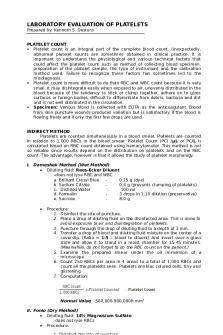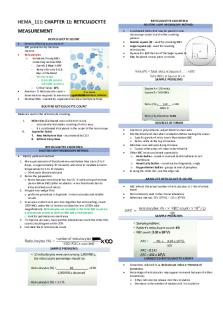Platelet Count hematology 2 PDF

| Title | Platelet Count hematology 2 |
|---|---|
| Course | Hematology 2 |
| Institution | Our Lady of Fatima University |
| Pages | 2 |
| File Size | 245.3 KB |
| File Type | |
| Total Downloads | 923 |
| Total Views | 975 |
Summary
HEMA2LAB WPLATELET COUNTDIRECT PLATELET COUNT(using neubauer chamber) PLATELET The Platelets , also known as Thrombocytes , are the oval, round or rod- like cells present in the blood that helps mainly in the cloing of blood; they are fragments of megakaryocytes present in peripheral blood FUNCT...
Description
HEMA2LAB W4 PLATELET COUNT DIRECT PLATELET COUNT (using neubauer chamber) PLATELET The Platelets, also known as Thrombocytes, are the oval, round or rodlike cells present in the blood that helps mainly in the clotting of blood; they are fragments of megakaryocytes present in peripheral blood FUNCTION: prevent excessive bleeding; maintain stability of capillaries On an average, the size of the Platelets is 2-4 µm (microns). The mature Thrombocytes are non-nucleated cells with a minute granules present in the cytoplasm and there is no pigment present in Platelets. The Average lifespan of Platelets is 9-12 days. Normally about 150,000 – 450,000 cells are present per cubic millimeter (mm3) of blood.
Chamber is used and in some laboratories, other types of chambers are also employed like Burkers chamber, Levy’s chamber and Fusch – Rosenthal chamber etc. For Platelets Count, the cells are counted in the 5 squares of the Central square as 4 Corner squares of the Central square (divided into 25 squares) and 1 central square of the Larger Central Square (divided into 25 squares) which is same as for Red Blood Cells. •
• PRINCIPLE OF TOTAL PLATELET COUNT USING HEMOCYTOMETER Very large numbers of Platelets/ Thrombocytes are present in the Blood Specimen. Practically, counting this amount of Platelets directly under the microscope is highly impossible. So, the Platelets / Thrombocytes are counted by using a special type of chamber, designed for the counting of blood cells in the specimen, known as Hemocytometer or Neubauer’s chamber. For this, the blood specimen is diluted (usually in 1:200 ratio) with the help of Platelet diluting fluid (commonly the Rees – Ecker Fluid) which preserve and fix the Platelets / Thrombocytes and stains it. The Rees-Ecker fluid (color dark blue) is isotonic to the Platelets / Thrombocytes and does not cause any damage to it whereas causes the lysis of red blood cells. Function of Rees-Ecker: To dilute blood sample Theoretically to stain platelets To prevent platelet clumping After diluting the specimen in appropriate dilutions, the content is charged on Hemocytometer / Neubauer’s chamber and the cells are counted in the areas specific for Platelet count.
•
• • •
1 large square at center Large square is divided into 25 smaller squares Smaller squares are divided into 16 smallest squares Length = 1mm Width = 1mm AREA OF 1 LARGE SQUARE (L x W) = 1 mm2 pero ang binilangan lang natin ay 5 smaller squares, so hindi
eto ang kasama sa formula MATERIALS: Neubauer counter Pipette – RBC pipette Cover slip
5 ang smaller squares are binibilangan sa RBC/ platelet = 5 smaller x 16 smallest = 80 smallest squares are counted L= 0.2mm; W = 0.2 mm AREA OF A SMALLER SQUARE (L x W) = 0.04 mm2 AREA COUNTED = 0.04 x 5 smaller squares = 0.2 mm2
RBC PIPETTE:
• • 0.5
1.0
•
101
B. • • PARTS: Stem, Bulb MARKINGS = 0.5, 1 = 101 marking (total unit of fluid capacity)
•
Ang amount ng dugo na iaaspirate ay hanggang 0.5 usually; after non wipe the stem of RBC pipette After blood, aspirate REES-ECKER diluting fluid (color dark blue) Lahat ng dugo mapupunta sa bulb Q: Bakit 1:200 platelet/rbc count eh wala namang 200 marking sa rbc pipette? = yung laman ng bulb ay 0.5, ang total unit ng bulb ay 100, ang ratio ng dugo vs overall fluid 0.5:100; gusto mo gawing whole number para walang butal; so multiply mo sya sa 2 pero dapat both kaya nagiging 1:200 This is a special type of glass chamber that is used for the cell counting, especially for Blood cells. Nowadays, most commonly Improved Neubauer’s
•
C. • D.
PROCEDURE: A. Diluting the blood • The bore of the RBC pipette is rinsed with Rees-Ecker diluting fluid (purpose para pag nag-aspirate hindi mag cclot ang sample) Draw blood up to 0.5 mark; clean the stem of pipette Dilute the blood with Rees-Ecker solution by filing the pipette up to 101 mark Shake the pipettes for at least 1 minute Charging the chamber Lagyan ng cover slip ang ibabaw ng chamber Discard the first 5 drops from the pipette and charge the hemocytometer (pag nag mix ka, yung dugo ay nasa bulb, yung stem puro diluting fluid lang so gusto mo idiscard muna yung puro diluting fluid) Alalay ang finger sa dulo ng pipette, intaying mamuo sa dulo ang fluid then yun ang ittouch sa chamber. Dapat ang fluid nasa gitna ng cover slip at counting chamber After charging, the hemocytometer should be kept in a covered container for 10-15 minutes with wet gauze (kuha ng petri dish, lagyan ng wet tissue, pag sa open air lang, mag eevaporate si rees-ecker) (hindi pa stable ang platelets kaya nag fflow pa sila so need istabilize) Counting Carefully place the hemocytometer on the microscope stage and count platelets in 5 RBC squares using HPO Calculation
Dilution factor = 200 (depends on the dilution) Depth (distance ng chamber) = 0.1 (constant) Area counted = 0.2 mm2 Reference range: 150-400 x109/L
Clump of platelets happens in: Traumatic collection Slow preparation Counting cells in a HEMACYTOMETER
PLATELET COUNT: INDIRECT METHOD (using blood smear) PURPOSE: to double check your direct plt count PROCEDURE: 1. Make a well-made blood smear and stain with Wright’s or Wright’s -Giemsa stain.
Left to right, Down right to left, and so on
According to the rules: Count cells inside the square Count the cells touching the LEFT and UPPER GRID LINES Do not count the cells touching the right and lower grid lines SAMPLE: TOO BLUE Causes Incorrect preparation of stock Eosin concentration too low Stock stain exposed to bright daylight. Batch of stain solution overused Impure dyes Staining time is too short Staining solution too acid Film is too thick Inadequate time in buffer solution
TOO PINK Causes Incorrect proportion of azure B: eosin Y Impure dyes Buffer pH too low Excessive washing in buffer solution
27 platetet counted
Plt count = 2. 3. 4.
5. 6.
Focus the slide using low power magnification. Examine the smear for areas that is suitable for counting Using the high magnification (HPO), check the area of smear for suitability for counting the platelets Shift the objectives to the 1000 x magnification. Examine the smear
Count and record the platelets seen in ten consecutive fields. Calculation To estimate a platelet count from the blood smear you regard each platelet seen per oil field as being equivalent to 20,000 mm3. By determining the average number of platelets seen per oil field multiplying this number by 20,00 you can estimate the platelet count. For example, if you see 10 platelets per oil field your estimated could be; 10 x 20,000. Usually 8-20 platelets per OIF represent a normal platelet count
27 x 200 x 106 0.2mm2 x 0.1...
Similar Free PDFs

Platelet Count hematology 2
- 2 Pages

Platelet count notes
- 6 Pages

2 - Count Zero Pdf
- 183 Pages

Hematology 2 Midterms Notes
- 12 Pages

Hematology 2 Final Exam
- 27 Pages

MTAP-3-Hematology - hematology
- 13 Pages

Platelet Disorders - W13 ( Notes)
- 18 Pages

Hematology Reviewer
- 15 Pages

Reticulocyte Count
- 2 Pages

Hematology exam
- 7 Pages

Hematology Reviewer
- 9 Pages

Hematology exam
- 6 Pages

Hematology Analyzer
- 3 Pages

HEMA Reticulocyte Count
- 2 Pages
Popular Institutions
- Tinajero National High School - Annex
- Politeknik Caltex Riau
- Yokohama City University
- SGT University
- University of Al-Qadisiyah
- Divine Word College of Vigan
- Techniek College Rotterdam
- Universidade de Santiago
- Universiti Teknologi MARA Cawangan Johor Kampus Pasir Gudang
- Poltekkes Kemenkes Yogyakarta
- Baguio City National High School
- Colegio san marcos
- preparatoria uno
- Centro de Bachillerato Tecnológico Industrial y de Servicios No. 107
- Dalian Maritime University
- Quang Trung Secondary School
- Colegio Tecnológico en Informática
- Corporación Regional de Educación Superior
- Grupo CEDVA
- Dar Al Uloom University
- Centro de Estudios Preuniversitarios de la Universidad Nacional de Ingeniería
- 上智大学
- Aakash International School, Nuna Majara
- San Felipe Neri Catholic School
- Kang Chiao International School - New Taipei City
- Misamis Occidental National High School
- Institución Educativa Escuela Normal Juan Ladrilleros
- Kolehiyo ng Pantukan
- Batanes State College
- Instituto Continental
- Sekolah Menengah Kejuruan Kesehatan Kaltara (Tarakan)
- Colegio de La Inmaculada Concepcion - Cebu

